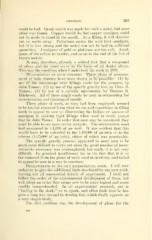Page 631 - My FlipBook
P. 631
AMAliGAM. 305
could be had. Great search was made for such a metal, but none
other was found. Copper would do, but copper amalgam could
not be made to stand in the mouth. As a filling, it will dissolve
out or waste away. Palladium makes the next best amalgam,
but it is less strong and the metal can not be had in sufficient
quantities. Amalgams of gold or platinum are too soft. Amal-
gams of tin refuse to harden, and so on to the end of the list of
known metals.
It was, therefore, already a settled fact that a compound
of silver and tin must serve as the basis of all dental alloys.
This was the condition when I undertook the work in 1895.
Measurement of bulk changes. Three plans of measure-
ment of bulk changes have been shown to be possible: (1) by
use of the microscope over fillings made for the ])urpose, by
John Tomes; (2) by use of the specific gravity test, by Chas. S.
Tomes; (3) by use of a suitable micrometer, by Thomas B.
Hitchcock. All of these might easily be used in conjunction for
corroboration and checking of results.
These plans of work, as they had been employed, seemed
to be too far removed from what we see and experience in filling
teeth to appeal to men as illustrating the failure or success of
amalgam in making tight fillings when used in teeth, except
that by John Tomes. In order that men may be convinced, they
must be able to see open cavity margins. The micrometers used
had measured to 1-1,000 of an inch. It was evident that this
would have to be extended to the 1-10,000 of an inch or to the
micron (1-25,000 of an inch), either of which was practicable.
The specific gravity process appeared to most men to be
much more difficult to carry out when the great number of meas-
urements necessary was contemplated, but really it is not very
difficult. Its greatest insufficiency lay in the fact that it is so
far removed from the plans of work used in dentistry and failed
to appeal to men in a way to convince.
Developments by my own expeeimental wobk. I will now
endeavor to give the additional facts developed by my own work,
leaving out all unessential details of experiment. I shall not
follow the order of the experimental development of these, but
will adopt an order that seems now to be more logical and more
readily comprehended. In all experimental research, one is
"feeling in the dark," so to speak, and often finds that he has
gone a long way aroimd to develop that which finally appears as
a very simple truth.
The first problem was the development of plans for the
—
41&


